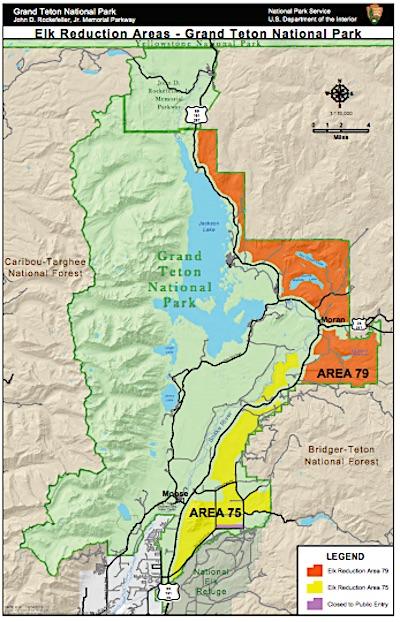
The annual elk reduction hunt gets under way in Grand Teton National Park this weekend in select areas/NPS
An annual hunt aimed at managing the population of elk in the Jackson Hole valley gets under way in Grand Teton National Park in Wyoming on Saturday and will continue into early December.
Authorized through the park’s enabling legislation of 1950, the program allows for the proper management and conservation of the Jackson Elk Herd, according to a park release.
The legislation directs Grand Teton National Park to jointly develop this program with the Wyoming Game and Fish Department, and for the governor of Wyoming and secretary of the Interior to approve the annual plan. Respective federal and state biologists and administrators have reviewed available biological data and concluded that the program is necessary for the proper management and protection of the elk, including keeping the herd at or near the population objective.
The areas open to the program, Wyoming Game and Fish Department Elk Hunt Areas 75 and 79, are generally located on the east side of the park, and north of the Gros Ventre River. The Snake River Bottom, between Deadman’s Bar access road to Ditch Creek west of US Highway 26/89/191 is closed to the program. The Antelope Flats area is closed to the program after November 30, and the entire program ends December 11. The areas remain open to park visitors, and the wearing of orange or other bright colors is highly recommended during this time.
The park’s elk reduction program is an important management tool that differs somewhat from other elk hunting programs in the region. Participants in the program must carry appropriate state license, conservation stamp and permits, use non-lead ammunition, and are limited in the number of cartridges they are able to carry each day. The use of archery, hand guns, or other non-center fire ammunition rifles is not permitted, nor is the use of artificial elk calls. In addition, participants, regardless of age, are required to carry a certified hunter safety card, wear fluorescent orange and carry and have immediately accessible bear spray as a non-lethal deterrent for use during potential bear encounters. Information packets accompanying each permit warn participants of the risk of bear encounters and offer tips on how to minimize the probability of human-bear conflicts.
Park officials say the need for this reduction program stems partly from an intensive management framework that includes annual winter feeding programs on the National Elk Refuge and in the upper Gros Ventre Drainage. Feeding sustains high numbers of elk with unnaturally low mortality rates. A majority of elk that are fed during the winter on the refuge also summer in Grand Teton National Park or use migration routes across park lands. The reduction program targets elk from three primary herd segments: Grand Teton, southern Yellowstone National Park, and the Teton Wilderness area of Bridger-Teton National Forest.
Park rangers will intensively monitor and patrol elk reduction areas to ensure compliance with rules and regulations, interpret the elk reduction program to visitors, and provide participants with information on local conditions associated with this wildlife management program.



Comments
They have to run program B because they run program A. Wouldn't it be simpler to stop running program A, thus eliminating the need for program B? Then the time, effort and money spent on both programs could be redirected elsewhere?